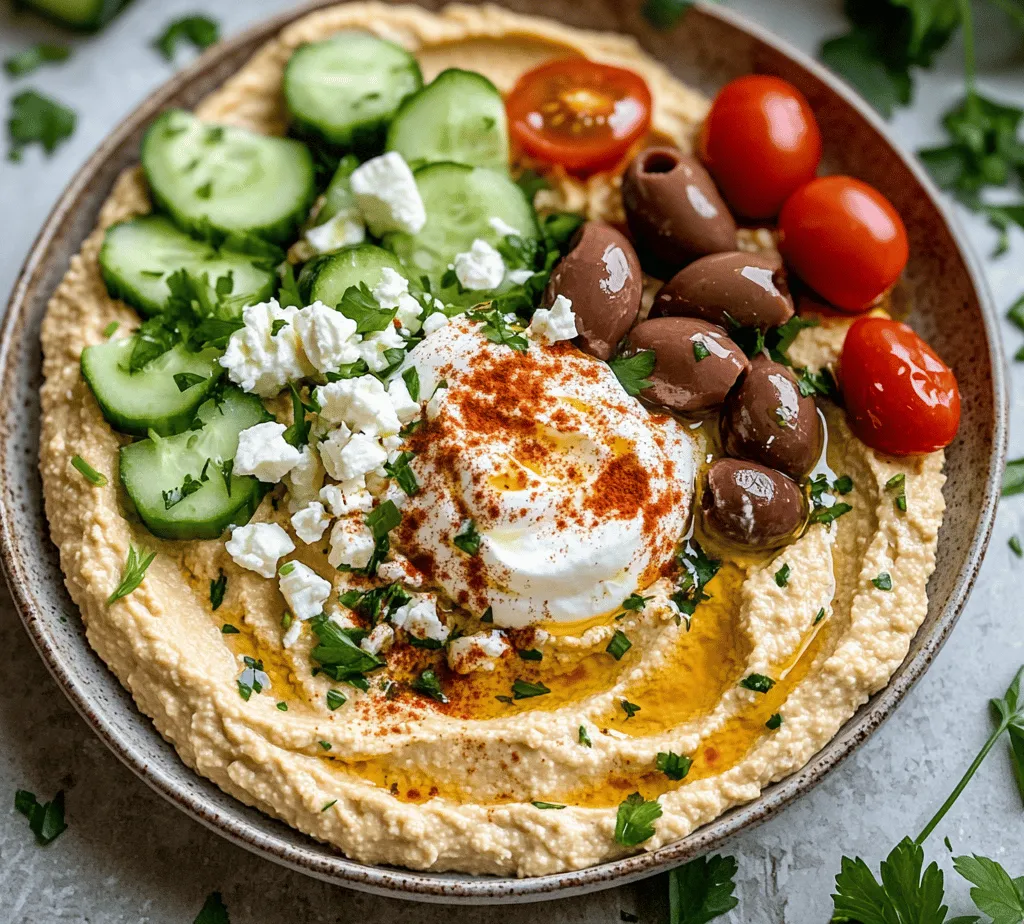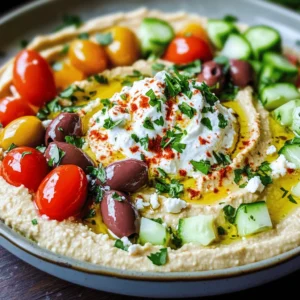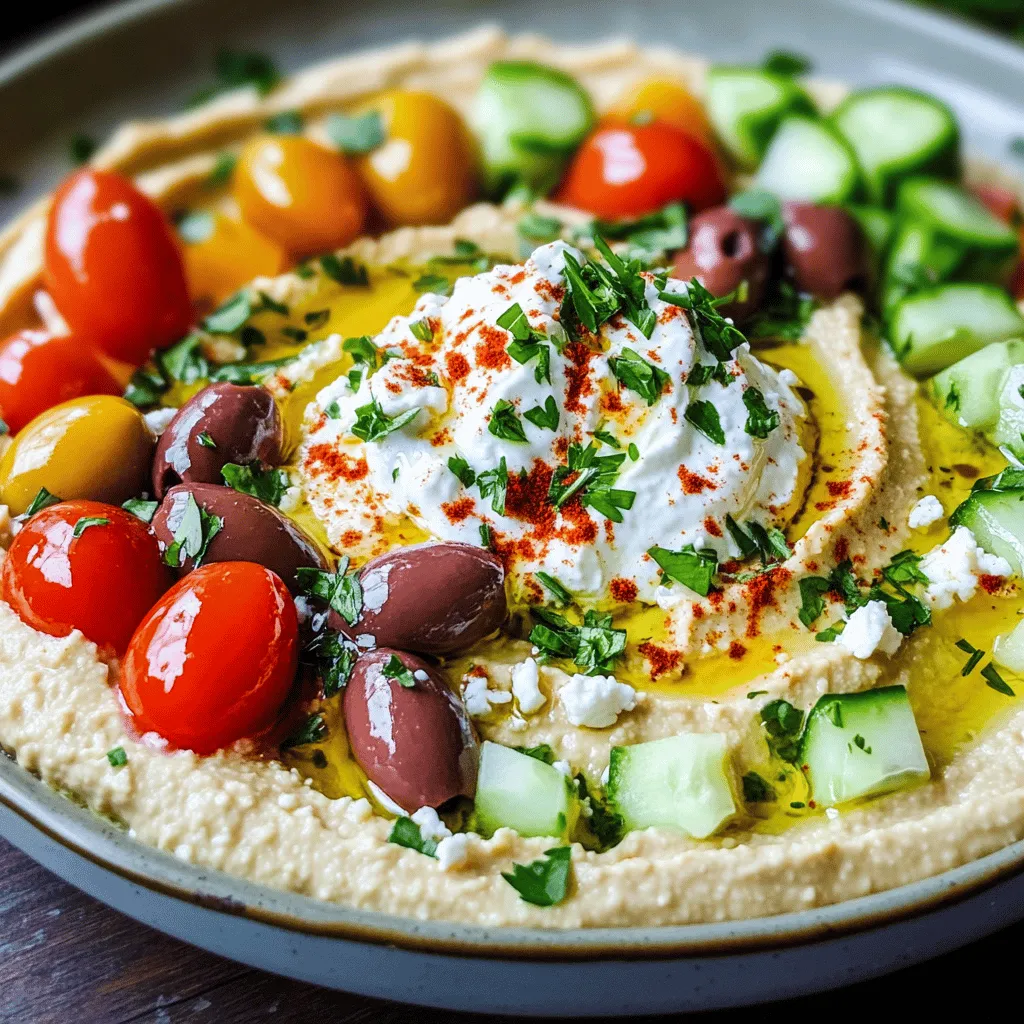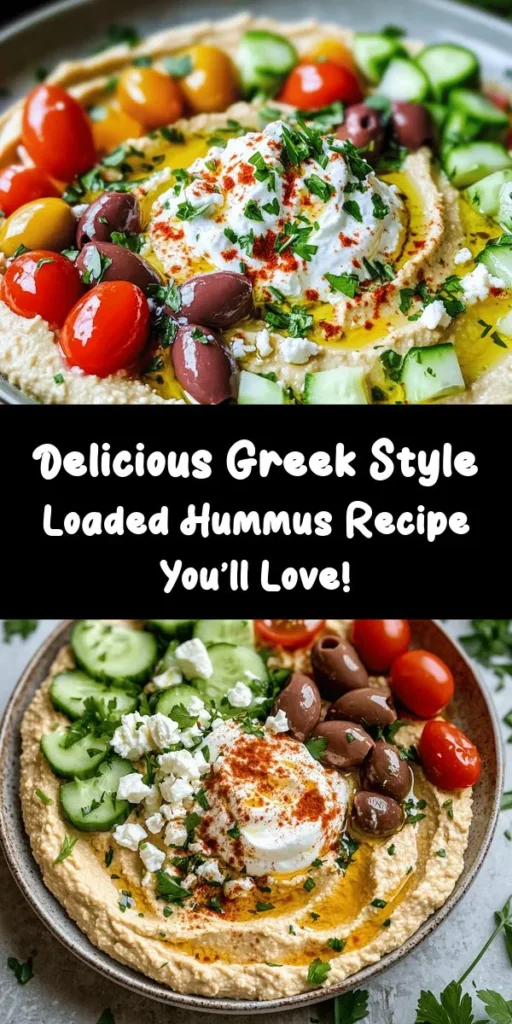Introduction
The Mediterranean diet is widely celebrated not only for its delicious flavors but also for its numerous health benefits. This dietary pattern emphasizes the consumption of whole grains, fresh fruits and vegetables, healthy fats, and lean proteins, making it a cornerstone of healthy eating. Among the myriad of dishes that embody the Mediterranean spirit, hummus stands out as a versatile, nutritious, and delicious option. Today, we’ll explore the recipe for Greek Style Loaded Hummus, a delightful twist on the traditional chickpea dip that is perfect for any occasion—whether it’s an appetizer at a dinner party, a healthy snack, or a flavorful addition to your meal prep.
One of the most compelling reasons to make your own hummus at home is the ability to customize the flavors and ingredients to suit your taste. Store-bought hummus, while convenient, often contains preservatives and additives that can compromise the purity and freshness of the dish. By preparing Greek Style Loaded Hummus in your kitchen, you can control the quality of each ingredient, ensuring a rich, creamy, and flavorful result that will impress your family and friends.
Understanding Hummus: A Mediterranean Staple
Hummus has a rich history rooted in Mediterranean cuisine. While its exact origins are debated, it is widely believed to have originated in the Levant region, with variations found throughout the Middle East and Mediterranean countries. The basic components of traditional hummus include chickpeas, tahini, olive oil, lemon juice, and garlic, all blended to create a smooth, creamy dip that pairs beautifully with pita bread, fresh vegetables, or as a spread in sandwiches.
The primary ingredient in hummus, chickpeas, is packed with nutritional benefits. They are an excellent source of plant-based protein, fiber, and essential vitamins and minerals. Chickpeas help maintain healthy digestion, stabilize blood sugar levels, and contribute to heart health. When combined with tahini, which is made from ground sesame seeds, the nutritional profile of hummus becomes even more impressive. Tahini is rich in healthy fats, protein, calcium, and antioxidants, making it a powerhouse ingredient in this Mediterranean staple.
In Greek culture, hummus is a beloved dish, often enjoyed as part of a mezze platter alongside other appetizers like dolmades, tzatziki, and olives. However, variations of hummus exist across different regions, with each culture adding its unique flair. The Greek Style Loaded Hummus takes this traditional dip to the next level by incorporating fresh ingredients and toppings that are characteristic of Greek cuisine, such as feta cheese, olives, and vibrant vegetables.
Ingredients Breakdown
To create the perfect Greek Style Loaded Hummus, it’s important to understand each ingredient’s role in the dish, as well as its health benefits. Here’s a detailed breakdown of the key ingredients you will need:
Chickpeas
Chickpeas, also known as garbanzo beans, are the star ingredient in hummus. These legumes are not only delicious but also highly nutritious. A single serving of chickpeas provides a wealth of nutrients, including protein, fiber, iron, and folate. They are known for their ability to promote satiety, making them an excellent choice for those looking to maintain a healthy weight.
Chickpeas are also versatile; they can be used in a variety of dishes, from salads to stews. When making hummus, you can use canned chickpeas for convenience or dried chickpeas that you soak and cook yourself for a more authentic flavor.
Tahini
Tahini is a key ingredient that adds creaminess and depth of flavor to hummus. Made from ground sesame seeds, tahini is a staple in Middle Eastern cuisine and has gained popularity worldwide for its rich taste and health benefits. It is an excellent source of healthy fats, protein, calcium, and iron. Additionally, tahini contains antioxidants that can help fight inflammation and support overall health.
When selecting tahini, look for high-quality, pure tahini that contains no additives or preservatives. This will ensure that you get the best flavor and texture in your hummus.
Olive Oil
Olive oil is an essential component of Greek cooking and plays a significant role in the flavor of hummus. Known for its heart-healthy properties, olive oil is rich in monounsaturated fats and antioxidants. It has been linked to various health benefits, including reduced inflammation and improved heart health.
When making hummus, opt for extra virgin olive oil for the best flavor. Its robust taste will enhance the overall profile of the dish, and a drizzle of high-quality olive oil on top of your loaded hummus will elevate its presentation and taste.
Fresh Produce
Incorporating fresh produce is crucial for creating a vibrant and nutritious Greek Style Loaded Hummus. Ingredients like cucumbers, tomatoes, and parsley not only add color and texture but also provide essential vitamins and minerals.
– Cucumber: Crisp and refreshing, cucumbers are low in calories and high in water content, making them a hydrating addition to your hummus.
– Tomatoes: Juicy tomatoes add a burst of flavor and are packed with antioxidants, particularly lycopene, which is known for its health benefits.
– Parsley: This fresh herb is not only a garnish but also adds a punch of flavor and is rich in vitamins A, C, and K.
Feta Cheese
Feta cheese is a beloved ingredient in Greek cuisine and adds a salty, tangy flavor to the Greek Style Loaded Hummus. Made from sheep’s milk or a mixture of sheep and goat’s milk, feta is lower in calories and fat compared to many other cheeses, making it a healthier choice for adding creaminess to dishes. It also provides a good source of protein and calcium.
Incorporating crumbled feta into your hummus not only enhances the flavor but also adds a delightful texture that complements the smoothness of the chickpeas.
Smoked Paprika
Smoked paprika is a spice that brings depth and warmth to your hummus. Its rich, smoky flavor enhances the overall taste and adds a touch of complexity. Smoked paprika is made from dried and smoked red peppers and is known for its antioxidant properties, which can contribute to overall health.
Using smoked paprika in your Greek Style Loaded Hummus will give it a unique flavor profile that sets it apart from traditional hummus recipes.
Importance of Quality Ingredients
When it comes to making Greek Style Loaded Hummus, the quality of your ingredients is paramount. Fresh, high-quality ingredients not only enhance the flavor but also improve the nutritional value of your dish. Take the time to source the best chickpeas, tahini, olive oil, and fresh produce you can find. This commitment to quality will shine through in the final result, making your homemade hummus a standout dish that rivals any store-bought option.
Step-by-Step Preparation of Greek Style Loaded Hummus
Now that we’ve covered the ingredients, let’s dive into the preparation of Greek Style Loaded Hummus. The process is straightforward, and with a few tips, you can create a smooth and creamy dip that’s bursting with flavor.
Creating the Hummus Base
1. Prepare the Chickpeas: If you’re using dried chickpeas, soak them overnight and then cook them until tender. If you’re using canned chickpeas, drain and rinse them thoroughly under cold water. This step helps remove excess sodium and any metallic taste from the can.
2. Blend the Ingredients: In a food processor, combine the chickpeas, tahini, olive oil, lemon juice, garlic, and a pinch of salt. Blend until the mixture is smooth and creamy. Scrape down the sides of the bowl as needed to ensure all ingredients are well incorporated.
3. Achieving the Perfect Creamy Texture: To achieve that coveted creamy texture, it’s essential to blend the hummus long enough. Don’t rush this step! If your hummus seems too thick, add a little cold water, one tablespoon at a time, until you reach your desired consistency. The cold water will help create a silkier mouthfeel.
4. Balancing Flavors: Taste the hummus and adjust the flavors to your liking. If you prefer a tangier taste, add more lemon juice. For extra depth, consider adding more garlic or a bit of cumin. The balance of flavors is key to a delicious hummus, so don’t be afraid to experiment with different quantities.
5. Adjusting the Texture and Consistency: If your hummus is too thick, adding water can help, but be cautious not to make it too watery. The goal is to maintain a creamy consistency that holds its shape when served. If you find the texture is still not to your liking, consider blending in a bit more tahini or olive oil for added creaminess.
With these steps, you’ll have a delicious base for your Greek Style Loaded Hummus that’s perfect for topping with fresh ingredients and serving with your favorite dippers.
As we continue to explore the full recipe, we’ll delve into how to assemble the loaded hummus and create a stunning presentation that will wow your guests. Stay tuned for the next part, where we will cover the finishing touches and serving suggestions!

Preparing the Toppings
To elevate your Greek Style Loaded Hummus, preparing the toppings is essential. Fresh ingredients not only add color and texture but also enhance the overall flavor profile. Begin by selecting a variety of vegetables and herbs that complement the creamy hummus base.
Benefits of Incorporating Fresh Vegetables and Herbs
Fresh vegetables and herbs are packed with essential vitamins, minerals, and antioxidants, making them a perfect addition to your hummus. Ingredients like diced cucumbers, tomatoes, and bell peppers add crunch, while herbs like parsley and dill bring a burst of freshness. Not only do they enhance the taste, but they also contribute to the visual appeal of the dish, making it a feast for the eyes and the palate.
How to Season the Topping Mixture for Maximum Flavor
To maximize flavor, seasoning is key. Combine your chopped vegetables with a drizzle of olive oil, a pinch of salt, and freshly cracked black pepper. This simple mixture can be elevated further with a squeeze of lemon juice or a sprinkle of za’atar, a Middle Eastern spice blend that typically includes oregano, thyme, and sesame seeds. Toss everything together until well combined, allowing the flavors to meld beautifully while you prepare the hummus.
Assembling the Dish
Assembling your Greek Style Loaded Hummus is an art that balances both flavor and aesthetics. Start by spreading a generous amount of your hummus onto a large serving platter or shallow bowl.
Techniques for Presentation and Visual Appeal
For an eye-catching presentation, create a smooth, even layer of hummus with the back of a spoon. Use the spoon to create gentle swirls or peaks, which will catch the eye and invite guests to dig in. The key to a beautiful dish is to keep the edges clean and the surface smooth, ensuring that the toppings stand out.
Suggestions for Creating a Shallow Well for the Yogurt
Next, create a shallow well in the center of the hummus. This well is essential for holding the toppings and yogurt, which will help keep the dish cohesive. To create the well, gently press down with the back of the spoon, forming a small depression that can hold your yogurt and toppings securely.
Garnishing for Flavor and Aesthetics
Garnishing is the final touch that transforms your dish from ordinary to extraordinary.
The Role of Parsley and Smoked Paprika in Enhancing the Dish
Sprinkle freshly chopped parsley over the entire dish for a pop of color and freshness. Parsley not only brightens the appearance but also adds a subtle herbal flavor that complements the hummus beautifully. For a touch of warmth and a hint of smokiness, dust the dish with smoked paprika. This spice enhances the flavors while adding a striking red hue that contrasts well with the greens and yellows of the dish.
Serving Suggestions and Pairings
Greek Style Loaded Hummus is versatile and pairs well with a variety of accompaniments. Here are some of the best options to consider.
Best Accompaniments for Greek Style Loaded Hummus
When it comes to serving, pita bread is a classic choice. Opt for warm, soft pita that can easily scoop up the hummus. You can also include vegetable sticks—think carrots, celery, and bell peppers—offering a crunchy, fresh alternative. Crackers can provide an extra layer of texture and are an excellent choice for those seeking a bit of crunch.
Pita Bread, Vegetable Sticks, and Crackers: How to Choose and Prepare
For pita bread, consider using whole wheat or pita chips for a healthier option. If you prefer a homemade touch, you can bake your own pita by slicing rounds into triangles and toasting them until golden. For vegetable sticks, wash and cut your chosen veggies into manageable pieces, ensuring they are easy to dip. Crackers should be sturdy enough to hold up to the hummus without breaking—look for whole grain or seed-based options for added nutrition.
Suggestions for Drinks That Complement the Dish
To round out your meal, consider beverages that enhance the Mediterranean experience. Light, refreshing drinks such as sparkling water with a slice of lemon or a chilled glass of white wine will pair beautifully. If you’re looking for a non-alcoholic option, a mint-infused lemonade or a traditional Greek beverage like ouzo can be delightful choices.
Creative Ways to Serve and Enjoy Hummus at Gatherings
At gatherings, consider presenting your Greek Style Loaded Hummus as part of a mezze platter. Include a variety of dips, olives, and cheeses, allowing guests to sample different flavors. Alternatively, you can serve individual portions in small bowls, each topped with a dollop of yogurt and sprinkled with herbs, making it easy for guests to enjoy.
Nutritional Information and Health Benefits
Greek Style Loaded Hummus is not just delicious; it’s also packed with nutrition.
Overview of Calories, Protein, Fats, and Carbohydrates Per Serving
A typical serving of Greek Style Loaded Hummus, including the toppings, contains approximately 150-200 calories. This serving provides around 6-8 grams of protein, 8-10 grams of healthy fats, and 15-20 grams of carbohydrates. These values can vary based on the specific ingredients used and the serving size.
Discussion on How Greek Style Loaded Hummus Fits Into Healthy Eating Plans
This dish aligns perfectly with a balanced diet, offering a rich source of plant-based protein and healthy fats from the tahini and olive oil. It’s also high in fiber, thanks to the chickpeas, making it a satisfying option that can help keep you full longer.
Potential Dietary Benefits (Vegan, Gluten-Free, High Protein)
Greek Style Loaded Hummus is naturally vegan and gluten-free, making it suitable for various dietary preferences. Additionally, it is high in protein, which is essential for muscle repair and overall health. Its nutrient-dense ingredients make it an excellent choice for those looking to maintain a healthy lifestyle without sacrificing flavor.
Cultural Significance and Variations of Hummus
Hummus has deep roots in Mediterranean cuisine, with each region offering its own unique twist.
Exploration of Different Regional Hummus Variations in Mediterranean Cuisine
In the Middle East, for instance, you might find versions that include spices like cumin and coriander, while in Israel, it’s common to top hummus with sautéed mushrooms or spiced ground meat. Each variation reflects local tastes and available ingredients, highlighting the versatility of hummus as a dish.
How the Greek Style Loaded Hummus Reflects Traditional Greek Ingredients
Greek Style Loaded Hummus showcases traditional Greek ingredients, such as olive oil, yogurt, and fresh herbs. These ingredients are staples in Greek cuisine, adding depth and authenticity to the dish. The use of tzatziki-style yogurt topping is particularly reflective of Greek culinary traditions, marrying the flavors of hummus with familiar Greek elements.
Ideas for Personalizing the Recipe with Additional Toppings or Flavors
Feel free to personalize your Greek Style Loaded Hummus by experimenting with different toppings. Consider adding roasted red peppers for sweetness, olives for brininess, or even crumbled feta cheese for a salty kick. You can also incorporate spices like sumac for a tangy flavor or chili flakes for heat, allowing you to tailor the dish to your personal taste.
Conclusion
In conclusion, Greek Style Loaded Hummus is a delightful blend of flavors, textures, and nutritional benefits that embodies the essence of Mediterranean cuisine. Its creamy base, paired with fresh toppings and garnishes, creates a dish that is both visually stunning and deliciously satisfying.
We encourage you to experiment with this recipe and its variations, inviting the vibrant flavors of Greece into your home. Whether you’re hosting a gathering or enjoying a quiet meal, this hummus is sure to impress. Embrace the joys of preparing and sharing homemade meals, and savor every delicious bite of your Greek Style Loaded Hummus.



